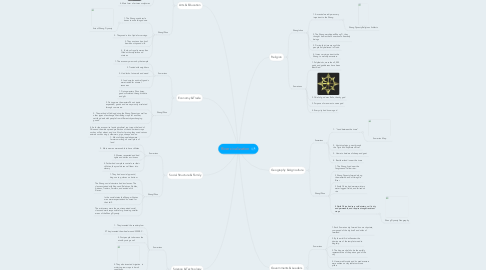
1. Economy & Trade
1.1. Sumerians
1.1.1. 1. The economy was run by the temple
1.1.2. 2. Traded with neighbors
1.1.3. 3. Had lack of minerals and wood
1.1.4. 4. food surplus and craft goods were traded for mineral resources
1.2. Shang/Zhou
1.2.1. 1. During western Zhou times, goods circulated through tribute and gift
1.2.2. 2. During wars the western Zhou's trade expanded, goods and money mostly circulated through commerce.
1.2.3. 3. The method of fishing during the Shang Dynasty as well as other types of exchange like trading crops for another, settling deals with people from different city exchanging goods.
1.2.4. 4. As for the economical and agricultural root crops the land of China and the wide spread production of their dominant crops such as millet, wheat, and rice. Also for farming they used various animals such as dogs, silkworms, pigs, sheeps and ox.
2. Social Structure & Family
2.1. Sumerians
2.1.1. 1. Most of the population were farmers working on small plots of land
2.1.2. 2. Most women were unable to have children
2.1.3. 3. Women respected and had rights and duties as citizens
2.1.4. 4. Father had complete control over their children, they could even sell them into slavery
2.2. Shang/Zhou
2.2.1. 1. They had a social pyramid, kings on top, slaves on bottom.
2.2.2. The Shang social structure had six classes. The classes started with Kings and Relatives, Nobles, Artisans, Traders, Farmers, and ended with Slaves.
2.2.3. In the social status the Shang militaries men were respected and honored for their skill.
2.2.4. The aristocracy were the most respected social class and were responsible for governing smaller areas of the Shang Dynasty.
3. Science & Technology
3.1. Sumerians
3.1.1. 1. They invented the seeder plow
3.1.2. 2.They invented the wheel around 3500 B.C.
3.1.3. 3. First people to harness the wind by using a sail
3.1.4. 4. They also invented irrigation in order to grow crops in harsh conditions
3.2. Shang/Zhou
3.2.1. 1. They used bronze to make weapons, parts of chariots and ritual vessels.
3.2.1.1. Shang/Zhou Technology
3.2.2. 2. They developed a complex flooding and irrigation systems.
3.2.3. 3. They used jade for many things.
3.2.4. 4. Toward the end of the Zhou Iron was starting to be used.
4. Arts & Education
4.1. Sumerians
4.1.1. 1. Made stone and clay statues of gods
4.1.2. 2. Had statues of half man mixed with bulls and goats
4.1.3. 3. Literature written in cuneiform script and contains prayers, hymns, myths, and more
4.1.4. 4. Main form of art was sculptures
4.2. Shang/Zhou
4.2.1. 1. The Shang used oracle bones to write things down.
4.2.1.1. Arts of Shang Dynasty
4.2.2. 2. They used a lot of jade for carvings.
4.2.3. 3. They wrote on books of bamboo strips and silk.
4.2.4. 4. Tombs of royalty were often filled with sculptures and statues.
5. Religion
5.1. Shang/zhou
5.1.1. 1. Ancestral worship was very important to the Shang.
5.1.1.1. Shang Dynasty Religious Artifacts
5.1.2. 2.The Shang worshipped Shang Ti, they thought he was the connection to heavenly beings
5.1.3. 3. During this time many of the people only believed in Gods.
5.1.4. 4. It was very important to the Shang to worship ancestors.
5.2. Samerians
5.2.1. 1. Polytheistic, more than 2,000 gods and goddesses have been identified.
5.2.2. 2. Chief of god was Enlin, the sky god
5.2.3. 3. Purpose of man was to serve god
5.2.4. 4. Every city had its own god
6. Geography & Agriculture
6.1. Sumerians
6.1.1. 1. "Land between the rivers"
6.1.1.1. Sumerian Map
6.1.2. 2. Vast dry plains, goes through the Tigris and Euphrates RIver
6.1.3. 3. Home to herders of sheep and goat
6.1.4. 4. Best farmland is near the rivers
6.2. Shang/Zhou
6.2.1. 1. The Shang lived near the Yangtze and Yellow river.
6.2.2. 2 Shang Dynasty formed along the western bend of Hwag He River
6.2.3. 3 South China had warmer winters, water logged fields, and thrived on rice
6.2.4. 4 North China had very cold winters, soil is dry and permeable, and require drought resistant crops
6.2.4.1. Shang Dynasty Geography
7. Governments & Leaders
7.1. Sumerians
7.1.1. 1. Each Sumerian city formed its own city-state, composed of the city itself and miles of farmland
7.1.2. 2. By the mid-3rd millennium the dominance of the temple turned to kingship
7.1.3. 3. The king was held to be the earthly representative of the patron god of the city
7.1.4. 4. Hammurabi's code and its predecessors were written on clay tablets or stone pillars
7.2. Shang/Zhou
7.2.1. 1. King Xun fought many defensive wars against non chinese in the north.
7.2.2. 2. The last king of the Shang, Shang Chou, was very cruel and known for torturing.
7.2.3. 3. During Western Zhou times, a network of city states formed on the plain.
7.2.4. 4. The Zhou ruled as coordinators more then a central government.
